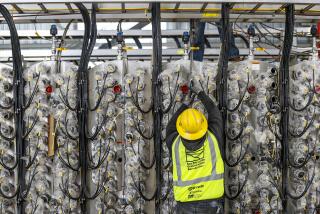Oil Firms Agree to Clean Up Morro Bay’s Tainted Water
While the foul-smelling gasoline additive MTBE has contaminated water wells around California, perhaps nowhere has it raised a bigger stink than in the picturesque tourist destination of Morro Bay.
After the chemical compound was found near city wells, an investigation turned up one bombshell after another. A former gas station employee testified in January that records had been falsified to hide leaks from gasoline storage tanks.
When Shell executives were questioned, they cited their 5th Amendment right to keep silent.
Now, both sides say all that acrimony is a thing of the past. Equilon, an alliance of Shell and Texaco, has agreed to fix the problem. Just last week, cleanup crews began pumping polluted water through a filtration system.
“I’m very happy,” said City Manager Bob Hendrix. “This is one of those rare situations where the city had a complete victory on an issue.”
The only question now is whether the cleanup will be completed in time for the city to use its Morro Creek basin wells when they could be sorely needed, several months from now.
“In the short term, we’re reasonably all right,” said Hendrix. “But the proof is in the pudding, and the pudding isn’t baked yet.”
MTBE was introduced into California gasoline stocks in large quantities in the mid-1990s in an effort to curb air pollution. Within a short time, however, the additive began showing up in ground water around the state.
Its health effects are still being debated, but Gov. Gray Davis has banned its use after 2002.
The problem in Morro Bay surfaced more than a year ago, when the city found that MTBE had gotten into the sewage plant through a cracked line. After months of testing, the city believed it had found the source: a Shell gas station at California 41 and Main Street.
Comparatively speaking, the levels were moderately high at 1,500 parts per billion. Even though that is 100 times higher than the state health standard, it is almost 100 times less than concentrations found at some places in Santa Monica.
“It’s not in the realm of the worst problems,” said John Rohrer, a geologist with Komex, a San Luis Obispo company that specializes in environmental cleanups.
But because it was so near the city’s drinking water wells, the pollution became a hot political issue in a town that treasures its resources and its natural setting on the fog-shrouded coast.
The heat was turned up another notch when officials learned that the city’s main water supply, the State Water Project, would be shut off this fall for maintenance.
That left the city on the water facing the prospect of not having a drop to drink. Preparing for the worst, the City Council declared an emergency in October, allowing local officials to require water conservation.
“You can do without gas or electricity, but you can’t do without water,” Mayor Rodger Anderson said at the time.
The city also tried to persuade the oil industry to do something about the pollution. But an Equilon representative said the company believed that the contamination was caused by customers who spilled a total of 5 gallons of gas.
Bringing in big legal guns, the city referred the case to the district attorney and hired Barry Groveman, co-author of Proposition 65. That is the law requiring warning labels on products that contain cancer-causing agents or substances that damage the reproductive system.
At a city hearing in January, a former employee of the station testified under oath that he had falsified records designed to track leaks from underground gasoline storage tanks. At the same hearing, five oil company officials refused to testify.
Shortly afterward, Equilon reached an agreement with the city to clean up the pollution. Cameron Smyth, a spokesman for Equilon, said a Cal Clean system to cleanse the ground water has been installed.
Smyth declined to comment about executives who took the 5th Amendment. As for allegations of false record keeping, Smyth said that activity was never reported to Equilon. The witness “was an employee of the independent retailer, not Shell or Equilon,” Smyth said.
As for the current relationship with the city, Smyth said, “We now have a very positive working relationship. It’s a complete team effort.”
The next hurdle for the city will come in November, when the State Water Project shuts down the pumps that supply Morro Bay. The interruption is expected to last 30 days, said Hendrix, during which the city must find an alternate source of water.
If its wells are not ready, Morro Bay has a plan that could include using a desalination plant built during the drought. The plant has sat idle in recent years because it is more expensive to operate than importing state water supplies.
More to Read
Sign up for Essential California
The most important California stories and recommendations in your inbox every morning.
You may occasionally receive promotional content from the Los Angeles Times.









